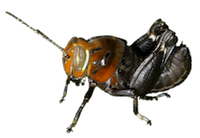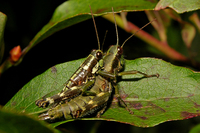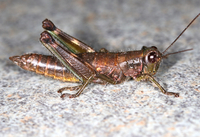Taxonomy
Family: Acrididae
Subfamily: MelanoplinaeTribe: PodisminiSynonym: Podisma glacialis variegata, Podisma variegata Comments: One of four species in this genus that occur in North America (Cigliano et al., 2016) and the only one that has been recorded in North CarolinaSpecies Status: Treated by some (e.g., BugGuide) as a subspecies of Booneacris glacialis. Cigliano et al. (2016), however, treat it as a full species. In the mountains of northern Virginia, both forms occur at the same sites and appear to occupy the same habitats (Caudell and Allard, 1936). Since they also appear to maintain distinctly different morphological features -- although not necessarily the differences in coloration described by Scudder and Blatchley -- it seems reasonable to treat them as separate species (although that was not done by Caudell and Allard themselves). In any case, all the specimens we have examined appear to be variegata, which is supported by the work of previous authors.
Identification
Field Guide Descriptions: Online Photographs: BugGuide (as Booneacris glacialis), Google Images ,
iNaturalist , GBIF Technical Description, Adults/Nymphs: Scudder (1897); Blatchley (1920) Comments: A medium-small, completely wingless grasshopper, the only one that occurs in North Carolina. Individuals of both sexes, but males in particular, are strongly variegated with dark brown and cream, tinged with greenish. The face, lower sides of the pronotum and hind femora are cream; a broad pale band also extends down the dorsal surface of abdomen in the males, but only a narrow line in females. A dark, shining band extends from behind the eye, along the upper sides of the pronotum and down the sides of the abdomen; the hind femora is also banded with contrasting dark brown. The fore and mid-legs are green, as is the hind tibia. In males, the hind femora are marked with coral red on the undersides and on the inner face. The strongly contrasting pattern and green legs are similar to that found in the Viridipes Group of Melanoplus and the possession of red patches on the hind femora is especially similar to that of Dendrotettix australis. Those species all have evident wings, however, albeit vestigial.Total Length [body plus wings; excludes ovipositor]: 16.5-20, males; 21-26.5, females (Blatchley, 1920)Structural Features: Unique among our grasshoppers in lacking any trace of wings; only a few of our crickets are similar in this regard but very different in other characteristics, especially in possessing much more elongate antennae and in their possession of extended ovipositors. In males, the furculae are very short -- less than half as long as the last abdominal segment to which they are attached; the cerci are narrowed at the middle, less than half as wide as the base. Both these traits were used by Scudder (1897) to distinguish variegata from glacialis. Blatchley added that the antennae of the males of variegata are one fourth longer than the hind femora, whereas the antennae and hind femora are roughly equal in glacialis. He also used the shape of the anterior margin of the pronotal disc as a key character: squarely truncate in variegata but rounded and slightly emarginate in glacialis.Structural photos
Nymphal Stages and Development: As in the adults, nymphs can be distinguished by their complete absence of wing buds, which are present, if small, in the nymphs of brachypterous species of Melanoplus and other grasshoppers.
Habitats and Life History
Habitats: Morse (1904) noted that this species "seems to be widely distributed in higher parts of the North Carolina mountains, inhabiting shrubby undergrowth and thickets of weeds and bushes". Our records range in elevation from 3,300 ft at Balsam to over 6,000 ft at Mount Mitchell, Grandfather Mountain, and Roan Mountain. Diet: Food plants are not mentioned but the species has been often found up in shrubs and small trees, including conifers. Conequently, it may feed on a wide variety of vegetation.Observation Methods: Found by flushing individuals by walking through their habitatsAbundance/Frequency: We currently have too little information to estimate either the frequency of occurrence or abundance of this species in North Carolina. Caudell (1936), however, noted that it "fairly swarmed in a tiny grassy meadow at about 6000 feet" on Mount Mitchell. That indicates that they may be locally abundant, at least at some sites.Adult Phenology: Adults are present from mid- to late summer

 »
»



 »
»

